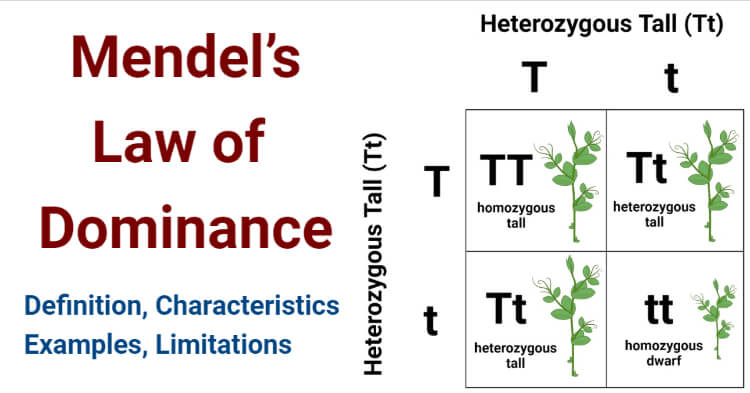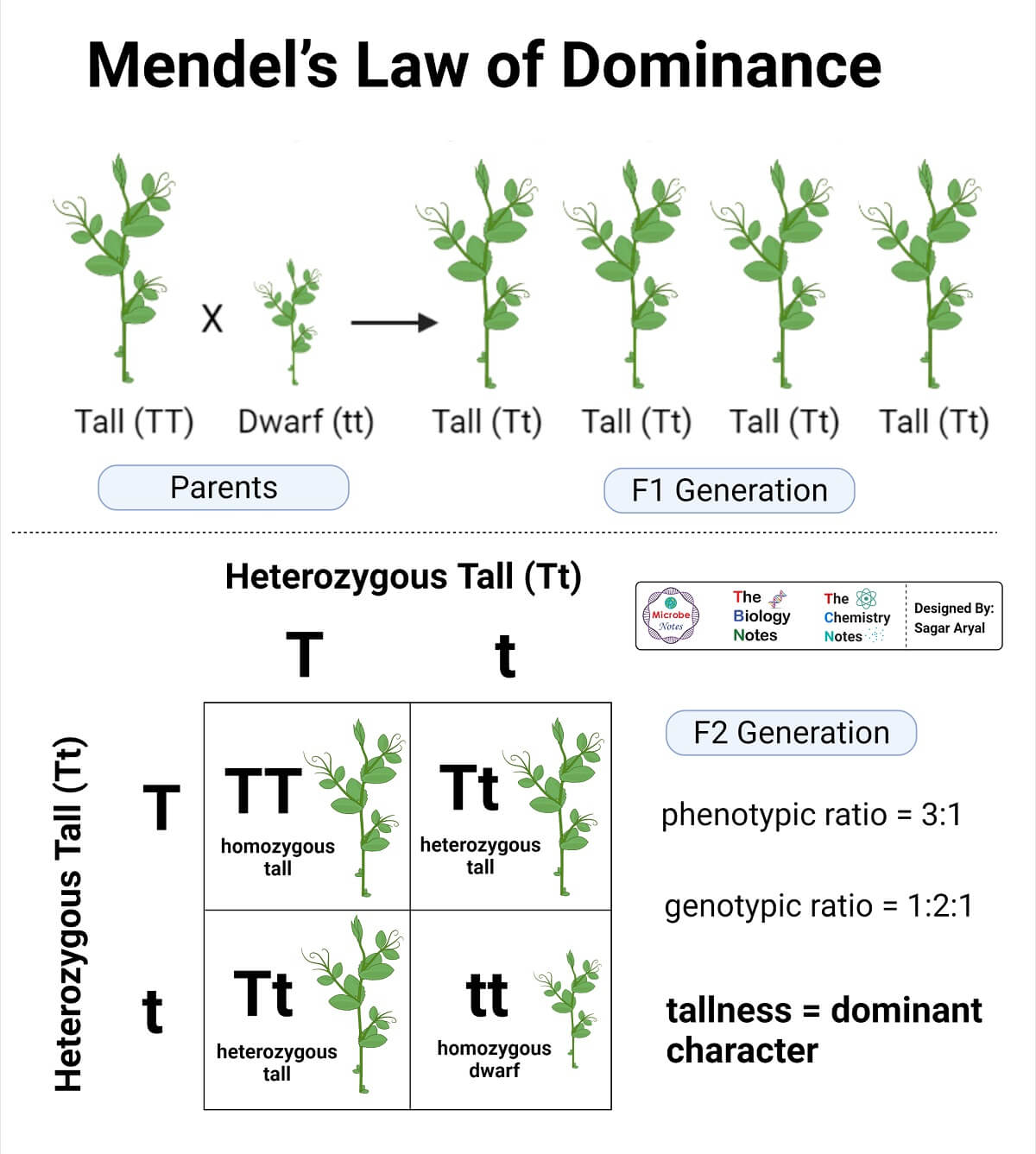Interesting Science Videos
Mendel’s Law of Dominance Definition
Mendel’s Law of Dominance states that ‘In crossing between homozygous organisms for contrasting characters of a pair, only one character of the pair appears in the first generation.’
- The law of dominance is the first law of heredity proposed from the works of Mendel. The law explains that all characters in an individual are controlled by distinct units called factors that occur in pairs.
- The pair can be homozygous or heterozygous, and in the case of heterozygous pairs, one of the factors dominates the other.
- The character that dominates is called the dominant character, and the one that remains unexpressed is the recessive character.
- The recessive character, even though latent, is transmitted to the offspring in the same way as the dominant character.
- The recessive character is only expressed when the offspring has two copies of the same allele resulting in a homozygous individual.
- The two alleles responsible for a character are brought together during fertilization, where one of the alleles comes from the maternal gamete and the other from the parental gamete.
- The concept of dominance is strictly only used for genotypic characters and does not represent the phenotype of the individual.
- With new experiments on genetics, many researchers believe that the law of dominance doesn’t always hold true and that other patterns of inheritance also exist.

Mendel’s Law of Dominance Characteristics
- The concept of dominance or the law of dominance originated from the concept of factors that transmit characters from the parents to the offsprings.
- Genes are the unit of inheritance that is transmitted via gametes that controls the expressions of different characters as a result of interaction with other genes.
- The genes occur within chromosomes which in the case of diploid cells occur in pairs. Each chromosome in the pair comes from a parent.
- Each of the contrasting characters is represented by an allele, resulting in two alleles for a pair of characters.
- Homozygous individuals have two identical alleles like the alleles TT in the case of the homozygous tall pea plant and tt in the case of the homozygous dwarf pea plant.
- The homozygous chromosomes are separated during gametogenesis so that the chromosome with T or t gene is passed to the gamete.
- During fertilization, the two gametes combine and produce a new individual with both the characters.
- The offspring is now called a heterozygote or hybrid as it contains two different genes for a pair of contrasting characters.
- The resulting hybrids all have tall stems, which indicate that the character of tallness is the dominant character and the dwarfness is recessive.
Examples of Mendel’s Law of Dominance
1. Guinea Pigs
- During the cross between a homozygous black guinea pig and a homozygous white guinea pig, the resulting hybrids in the F1 generation are all black.
- In this case, the black color is the dominant character, and the white color is the recessive character.
- When the black hybrids are mated among themselves, they produce both black and white offsprings in the ratio of 3:1.
- This result proves that the black color is the dominant character which is expressed in all organisms carrying the allele for that character.
- A single white guinea pig is produced, which contains homozygous alleles for the recessive character.
2. Pea plants
- One of the most prominent and important examples of dominance is in the case of pea plants. This is based on the experiments conducted by Mendel during his study.
- Mendel took a group of contrasting characters like the length of the stem, color of the seed, shape of the cotyledon, etc.
- Among these, he took the example of stem length with two contrasting characters; tallness and dwarfness.
- The homozygous allele for tallness is represented by TT, and the homozygous allele for dwarfness is represented by tt.
- After fertilization, the resulting hybrids might have the following possible genotypes; TT, Tt, and tt.
- The phenotypic ratio of the hybrid is in the ratio of 3:1, whereas the genotypic ratio is 1:2:1.
- Here, tallness is the dominant character as it dominates over dwarfness, whereas dwarfness is only expressed when present in homozygous conditions.

Limitations of Mendel’s Law of Dominance
Mendel’s law of dominance has a number of limitations which are mentioned below;
- The law is not applicable for all living organisms as it is only valid in the case of diploid organisms and the organisms that undergo sexual reproduction.
- Even though dominance was considered the only mode of inheritance, a number of different modes like blending inheritance have since been discovered and studied.
- Dominance also doesn’t occur in the case of all contrasting characters.
- In some cases, conditions of co-dominance or incomplete dominance might take place.
References and Sources
- Verma PS and Agarwal VK (3005). Cell Biology, Genetics, Molecular Biology, Evolution, and Ecology. Multicolored Edition.
- https://courses.lumenlearning.com/boundless-biology/chapter/laws-of-inheritance/ – 13%
- https://en.wikipedia.org/wiki/Genetic_dominance – 4%
- https://findanyanswer.com/what-is-law-of-dominance-class-10 – 2%
- https://www.scienceabc.com/pure-sciences/what-is-mendels-law-of-dominance.html – 2%
- https://www.toppr.com/ask/question/allele-for-tallness-is-dominant-over-allele-for-dwarfness-which-of-the-following-can-be/ – 1%
